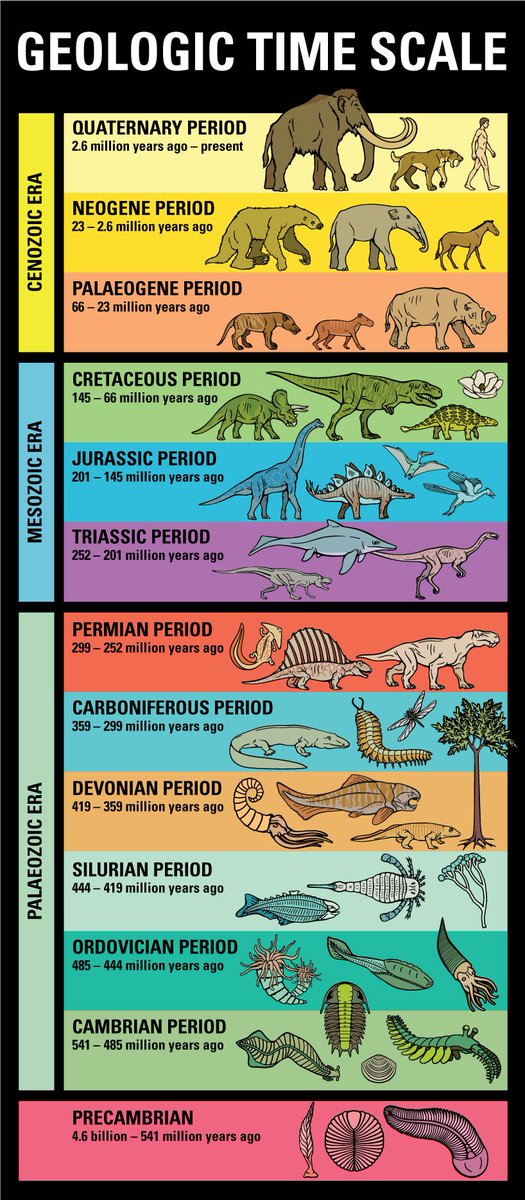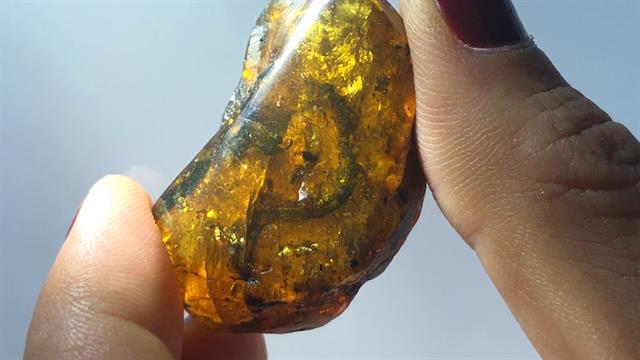Skip to comments.
99-Million-Year-Old Snake Hatchling Found Encased in Burmese Amber
Sci-News.com ^
| Jul 19, 2018
| News Staff / Source
Posted on 08/12/2018 9:05:43 AM PDT by ETL
The newly-reported specimen was obtained from an amber deposit in the Angbamo area in Myanmar’s Kachin province.
The fossil is a 1.6-inch (4.75 cm) long postcranial skeleton made up of 97 vertebrae; the snake’s head is missing. It dates from the Late Cretaceous epoch, approximately 99 million years ago.
“This snake, named Xiaophis myanmarensis, is linked to ancient snakes from Argentina, Africa, India and Australia,” said University of Alberta’s Professor Michael Caldwell.
“It is an important — and until now, missing — component of understanding snake evolution from southern continents, that is Gondwana, in the mid-Mesozoic.”
“At 99 million years old, it dates back to the age of the dinosaurs, well before snakes started to differentiate into modern groups,” added Dr. Alessandro Palci, from Flinders University and the South Australian Museum, Australia.
“This Asian fossil helps shed light on how primitive snakes dispersed from the southern to the northern continents.”
“Although found in the northern hemisphere, it strongly resembles South American snakes that lived at the time.”
The amber fragment in which Xiaophis myanmarensis was found also provided important clues about its environment.
“It is clear that this little snake was living in a forested environment with numerous insects and plants, as these are preserved in the clast,” Professor Caldwell said. ..."
About 150 million years ago (Late Jurassic epoch), Myanmar was joined to Australia, Antarctica, Africa and South America, forming the supercontinent Gondwana.
Through continental drift, Myanmar eventually separated from Gondwana and drifted north, until it collided with Asia.
(Excerpt) Read more at sci-news.com ...
TOPICS: Chit/Chat; Science
KEYWORDS: africa; alessandropalci; amber; angbamo; antarctica; argentina; australia; burma; cretaceous; crevo; godsgravesglyphs; gondwana; india; kachinprovince; lookbackinamber; lookslikeapenguin; mesozoic; myanmar; paleontology; reptiles; snakes; southamerica; storkzilla; xiaophismyanmarensis
Navigation: use the links below to view more comments.
first 1-20, 21-24 next last
 Photograph of the piece of amber containing Xiaophis myanmarensis and 3D reconstruction of its skeleton. Image credit: Ming Bai,
Photograph of the piece of amber containing Xiaophis myanmarensis and 3D reconstruction of its skeleton. Image credit: Ming Bai,
Chinese Academy of Sciences.

Light photographs of probable snake shed skin: (A) overall view of the complete specimen; scale bar – 5 mm; (B) close-up of the left portion of the specimen showing converging scale rows (center top);
scale bar – 1 mm; (C) close-up of the right mid-region of the specimen; scale bar – 1 mm. Image credit: Xing et al, doi: 10.1126/sciadv.aat5042.
1
posted on
08/12/2018 9:05:43 AM PDT
by
ETL
2
posted on
08/12/2018 9:05:57 AM PDT
by
ETL
(Obama-Hillary, REAL Russia collusion! Uranium-One Deal, Missile Defense, Iran Deal, Nukes: Click ETL)
3
posted on
08/12/2018 9:07:25 AM PDT
by
ETL
(Obama-Hillary, REAL Russia collusion! Uranium-One Deal, Missile Defense, Iran Deal, Nukes: Click ETL)
To: ETL
How many millions of dollars have been spent on snake revolution. What a racket!!
To: ETL
5
posted on
08/12/2018 9:08:46 AM PDT
by
HypatiaTaught
(Whatever's good for your soul, do it.)
To: ETL
Wow. So, lawyers have been around since the Mid-Mesozoic?
To: ETL
7
posted on
08/12/2018 9:09:58 AM PDT
by
Artemis Webb
(Maxine Waters for House Minority Leader!!)
To: All

"Hay que lindo eres"
8
posted on
08/12/2018 9:10:27 AM PDT
by
ETL
(Obama-Hillary, REAL Russia collusion! Uranium-One Deal, Missile Defense, Iran Deal, Nukes: Click ETL)
To: ETL; Fred Nerks
Which would you rather have , a snake in grass or a snake in glass?
9
posted on
08/12/2018 9:13:01 AM PDT
by
Candor7
((Obama Fascism)http://www.americanthinker.com/articles/2009/05/barack_obama_the_quintessentia_1.html)
To: neverevergiveup
So, lawyers have been around since the Mid-Mesozoic?Apparently Late Mesozoic. End of the Cretaceous. The very end of the dinosaurs' time.

10
posted on
08/12/2018 9:14:08 AM PDT
by
ETL
(Obama-Hillary, REAL Russia collusion! Uranium-One Deal, Missile Defense, Iran Deal, Nukes: Click ETL)
To: ETL
11
posted on
08/12/2018 9:15:25 AM PDT
by
Nifster
(I see puppy dogs in the clouds)
To: All
12
posted on
08/12/2018 9:22:32 AM PDT
by
ETL
(Obama-Hillary, REAL Russia collusion! Uranium-One Deal, Missile Defense, Iran Deal, Nukes: Click ETL)
To: Sacajaweau

"How many millions of dollars have been spent
on snake revolution. What a racket!!"


...never mind
13
posted on
08/12/2018 10:08:46 AM PDT
by
ETL
(Obama-Hillary, REAL Russia collusion! Uranium-One Deal, Missile Defense, Iran Deal, Nukes: Click ETL)
To: ETL
So that’s what James Carville hatched from.
14
posted on
08/12/2018 10:16:16 AM PDT
by
EvilCapitalist
(It's Ok to be white.)
To: EvilCapitalist
15
posted on
08/12/2018 10:34:57 AM PDT
by
ETL
(Obama-Hillary, REAL Russia collusion! Uranium-One Deal, Missile Defense, Iran Deal, Nukes: Click ETL)
To: ETL
"...1.6-inch..." Sigh.... That's roughly 1- 5/8", but they're too politically correct and eurofied to say it that way.
I miss America.
16
posted on
08/12/2018 10:36:48 AM PDT
by
Windflier
(Pitchforks and torches ripen on the vine. Left too long, they become black rifles.)
To: ETL
I always thought that snakes once had legs, but they disappeared over time. When did they have legs (if not 99 million years ago)??
17
posted on
08/12/2018 10:49:19 AM PDT
by
Cowboy Bob
("Other People's Money" = The life blood of Liberalism)
To: ETL
18
posted on
08/12/2018 11:01:58 AM PDT
by
Fungi
To: Cowboy Bob
Snakes With Legs Fossils
Eupodophis descouensi, about 20 inches long overall, exhibits a small leg, measuring under an inch long, attaching to its pelvis. Photo courtesy A. Houssaye.
An X-ray imaging technology is helping scientists to better understand how snakes lost their legs during the course of their development. The researchers said they hope the new data will serve to resolve a heated debate about the origin of snakes: whether they evolved from a terrestrial lizard or creatures that lived in the oceans. New, detailed 3-D images have revealed that the internal architecture of one ancient snake's leg bones strongly resembles those associated with modern terrestrial lizards.
The team of researchers was led by Alexandra Houssaye from the Museum National d'Histoire Naturelle (MNHN) in Paris, France, and included scientists from the European Synchrotron Radiation Facility (ESRF) in Grenoble, France, where the X-ray imaging was performed, and the Karlsruhe Institute of Technology (KIT), Germany, where a sophisticated technique and a dedicated instrument to take the images were developed.
Snakes With Legs
Only three specimens of fossilized snakes with preserved leg bones have been found to date, worldwide. Eupodophis descouensi, the ancient snake studied in this experiment, was discovered 10 years ago in 95 million-year-old rocks in Lebanon, in the Middle East. About 20 inches long overall, it exhibits a small leg, measuring under an inch long, attaching to its pelvis.
This fossil is key to understanding the origins of snakes, as it represents an intermediate stage when ancient snakes had not yet completely lost the legs that they had inherited from their lizard ancestors.
Although the fossil exhibits just one leg on its surface, a second leg was thought to be concealed in the stone, and indeed, this leg was revealed in full detail, thanks to synchrotron X-rays.
New Insights
The high-resolution 3-D images, in particular the fine detail of the buried small leg, suggest that this species lost its legs because they grew more slowly, or for a shorter period of time. The data also reveal that the hidden leg is bent at the knee and has four ankle bones but no foot or toe bones.
"The revelation of the inner structure of the hind limbs of Eupodophis enables us to investigate the process of limb regression in snake development," Houssaye said.
The scientists used “synchrotron laminography,” a recent imaging technique specially developed for studying large, flat samples. It is similar to the computed tomography (CT) technique used in many hospitals, but relies on a coherent synchrotron X-ray beam to resolve details a few micrometers in size -- some 1000 times smaller than a hospital CT scanner.
For this new technique, the fossil is rotated at a tilted angle in a brilliant high-energy X-ray beam, with thousands of 2-D images recorded as it makes a full 360 degree turn. From these individual images, a high-resolution, 3-D representation is then reconstructed, which shows hidden details such as the internal structures of the legs.
"Synchrotrons, these enormous machines, allow us to see microscopic details in fossils invisible to any other techniques without damage to these invaluable specimens," explains Paul Tafforeau of the ESRF, a co-author of the study which has been published in the Journal of Vertebrate Paleontology.
19
posted on
08/12/2018 11:06:40 AM PDT
by
ETL
(Obama-Hillary, REAL Russia collusion! Uranium-One Deal, Missile Defense, Iran Deal, Nukes: Click ETL)
To: ETL
Proof that Democrats were here LONG before Republicans.
20
posted on
08/12/2018 1:50:40 PM PDT
by
VeniVidiVici
(All Democrats have to offer is violence, intolerance, divisiveness and hatred.)
Navigation: use the links below to view more comments.
first 1-20, 21-24 next last
Disclaimer:
Opinions posted on Free Republic are those of the individual
posters and do not necessarily represent the opinion of Free Republic or its
management. All materials posted herein are protected by copyright law and the
exemption for fair use of copyrighted works.
FreeRepublic.com is powered by software copyright 2000-2008 John Robinson











